Your baby needs the same gear as you do to go camping, and that includes a sleeping pad. The sleeping pad is what insulates your baby from the ground so she stays warm in the night. Here’s what baby sleeping pad I use for camping, plus some tips on choosing the right pad.
Choosing the Right Baby Sleeping Pad
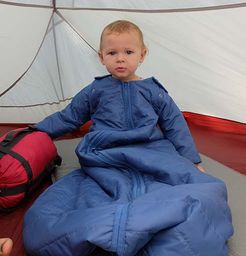
Here’s what you should think about when buying baby sleeping pad for camping. If you aren’t sure of your setup yet, read this post on How to Sleep in a Tent with a Baby.
R-value:
R-value is a measure of how much insulation the sleeping pad offers. To play it safe, I like to have at least an R-value of 3 for my baby.
You can put two sleeping pads on top of each other to get more R-value. For example, a pad with an R-value of 1 can go on a pad with an R-value of 2 to give a total of R-value 3.
Firmness:
Babies must sleep on a firm surface. Inflatable camping mattresses are not suitable for babies. However, babies can sleep on self-inflating camping pads or foam camping pads. Most backpacking air pads are firm enough for a baby, but it’s still safer to choose something firmer.
Width:
One issue with sleeping with a baby in a tent is that your baby may roll off the sleeping pad. If that happens, the ground will suck the heat from your baby’s body. You might consider an extra-wide pad so your baby is less likely to move off the pad. I’ve heard of people using patching glue and Velcro to attach all of their pads together to make a big pad which covers the entire sleeping area in the tent.
Does it fit the baby bed?
If you are using a baby camping bed, then you’ll need a pad which fits inside. Foam sleeping pads can be cut to fit the crib. Alternatively, you can put a sleeping pad underneath the baby bed.
Do you want to use the pad outside too?
I bring my baby’s sleeping pad outside during the day so she can lay/sit on it. The sleeping pad also doubles as a changing pad. For this reason, I prefer a foam sleeping pad. It won’t puncture like self-inflating pads.
Long-Term Use:
Want a sleeping pad that your baby can still use even as she gets older? One solution is to get an extra-long foam pad. Just fold the foam pad in half to shorten it (this will also double the R-value). Your baby or other family members can use that same pad later on.
Easy to Clean:
It’s almost inevitable that your baby will have a diaper explosion or (as they get older) an accident at night. So make sure you choose a sleeping pad which is easy to clean!
What about the Mattress in My Baby’s Camping Bed?
If you are using a camping bed for your baby, you will still probably need to bring a sleeping pad. Most portable baby beds have very thin mattresses which offer almost no insulation. You’ll need to put a sleeping pad inside or underneath the bed.
Another issue with foam mattresses is that they absorb pee like a sponge. Once wet, they take a long time to dry and your baby won’t have anything to sleep on in the meantime. By contrast, most camping sleeping pads are waterproof.
Best Baby Sleeping Pads for Camping
These are all adult sleeping pads which work great for babies too. I also recommend checking out REI’s Outlet. They often have huge discounts on good-quality pads.
Therm-a-Rest Trail Scout
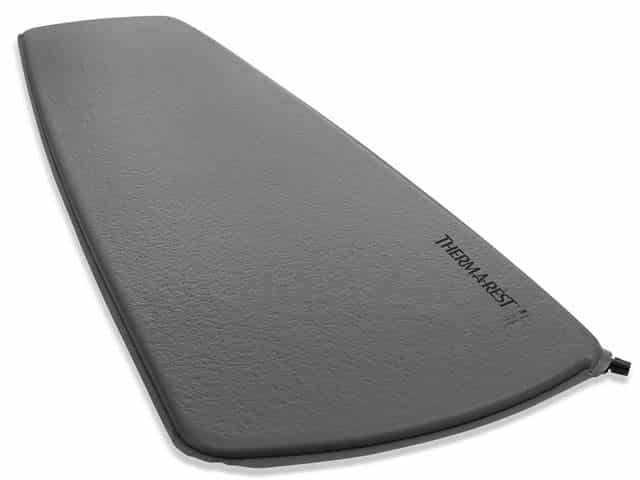
This self-inflating sleeping pad is comfortable and, at R-3.1, it is warm enough for cold-weather camping. It is also very lightweight and compact. There is a standard length as well as a short length available. My older daughter (10) also uses this sleeping pad, so it will grow with your child.
Nemo Switchback Pad
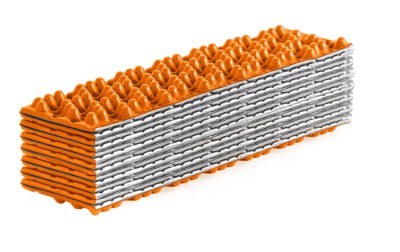
The NEMO Switchback is a comfortable foam sleeping pad which your baby will be able to use for many years. It is fairly warm at R-2 and is lightweight enough for backpacking trips.
I really like how the pad packs up accordion style. This also means the pad is easy to fold in half. Just get the long pad, fold in half, and your baby will get double the R-value. The folded pad also works great as a seat.
Be careful when you order the pad that you get the right size. The regular pad is 72 inches long and the short is just 51 inches. Both are the same width and thickness.
- Type: Foam
- R-value: 2
- Size: 72x20x0.9 inches (regular), 50x20x0.9” (short)
- Weighs: 14.5oz (regular), 10.5oz (short)
- Buy At: Amazon, REI
Therm-a-Rest Ridgerest
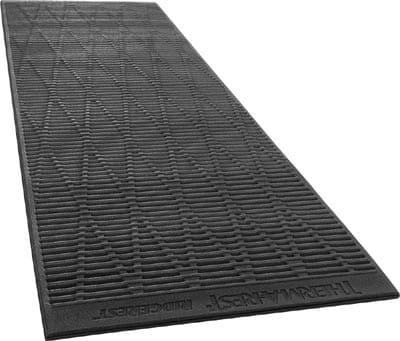
Here’s another sleeping pad by Therm-a-Rest. This one is a closed-cell foam pad. The foam is pretty dense and gives an R-value of 2.
The thing I like about the Therm-a-Rest is that it is cheap. You won’t have qualms about cutting it to fit your baby’s camping bed or even using part to line a stroller. The pad is available in regular and long sizes. Note that the long size is wider, so choose this if your baby tends to wriggle off the mat.
- Type: Foam
- R-value: 2
- Size: 72x20x0.625 inches (regular), 77x25x0.625” (long)
- Weighs: 14oz (regular), 19oz (long)
- Buy At: Amazon
EVA Foam Puzzle Piece Playmat
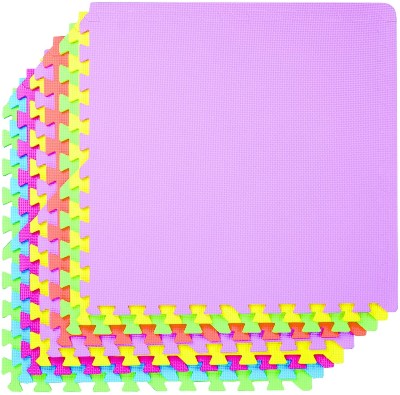
These foam playmat pieces work well as a baby sleeping pad for mild weather. What I like about these is that they are four times larger than most puzzle playmat pieces (4 sq. feet compared to 1 sq. foot). At 24×24 inches, they are wider than most camping sleeping pads
Because of their large size, you can easily take them out of the tent and put them on the ground so your baby has somewhere to crawl around outside.
EVA typically has an R-value of 4 per inch of thickness. Each piece is only 0.4 inches thick so these mat pieces are probably R-value 1.5 to 1.6. Stack the pieces on top of each other to make a thicker pad which provides more insulation and comfort.
- Type: Foam
- R-value: N/G
- Size: 24×24” (per tile; comes with 9 tiles)
- Weighs: 5lbs
- Buy At: Amazon
High-Density Foam Sleeping Pad
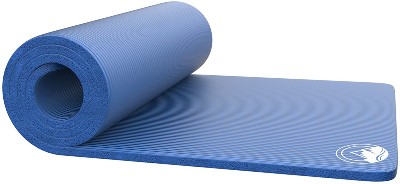
I really like these type of foam sleeping pads for camping with babies and little kids. They are cheap, durable, make great diaper changing pads and won’t burst even if you put them on sharp rocks or thorns. Just note that some foam sleeping pads are really thin and don’t insulate well. This one is 0.75 inches thick (most others are 0.5 inch thick or less). The R-value isn’t listed but it’s probably around R-2.
- R-value: 2
- Size: 24×24” (per tile; comes with 36 tiles)
- Weighs: 5lbs
- Buy At: Amazon
REI Double Camp Dreamer Sleeping Pad
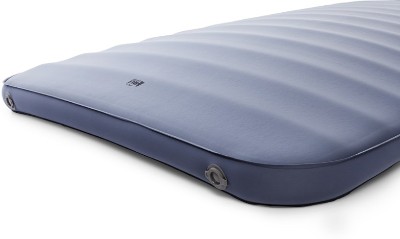
If you want to sleep comfortably and warm next to your baby in the tent, this double-wide sleeping pad by REI is great. It is 4 inches thick and has an R-value of 6.6 (warm enough for even winter). The pad is self-inflating, though you will need to give it a few blows to fully inflate. Once inflated, it’s firm enough for a baby’s back. I wouldn’t recommend sharing a pad with older babies who wriggle around a lot though. (Read about co-sleeping in the same sleeping bag with a baby).
- Type: Self-inflating
- R-value: 6.6
- Size: 78x55x4 inches
- Weighs: 9lbs 5oz
- Buy At: REI
KingCamp Double Self-Inflating Sleeping Pad
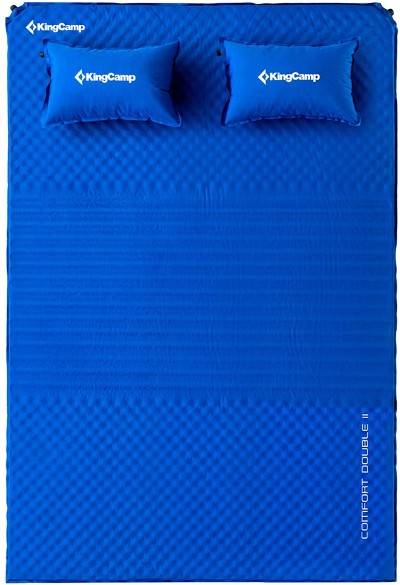
Here’s another double-wide sleeping pad if you want to co-sleep with your baby. It’s much cheaper than the REI pad above, so it shouldn’t be surprising that the quality isn’t as great. It is only 1.6 inches thick and there is no R-value given. Because it isn’t insulated, I doubt the R-value is much over R-2.5. It’s best for summer camping.
- Type: Self-inflating
- R-value: N/G
- Size: 78×51.2×1.6”
- Weighs: 9lbs 7oz
- Buy At: Amazon
Not sure what to bring camping? See this Printable Baby Camping Checklist. Also see these Tips for Camping with a Baby.
Resources:
https://www.foamtechchina.com/open-cell-foam-vs-closed-cell-foam/
https://backpackinglight.com/forums/topic/5464/
Image credit: Morrison sleeping bags – Read my review of their sleeping bag here


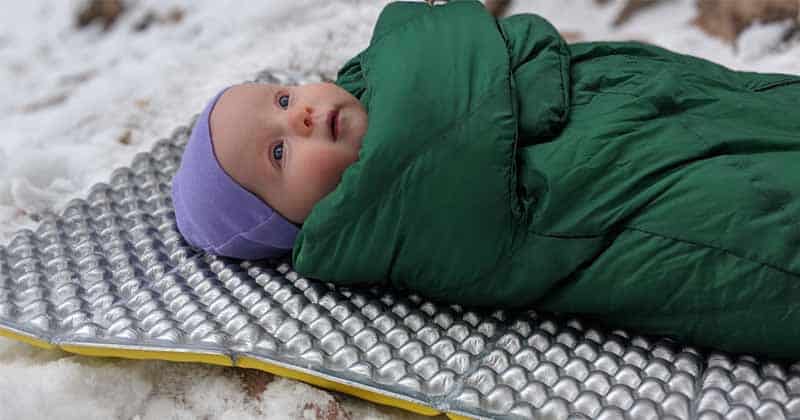
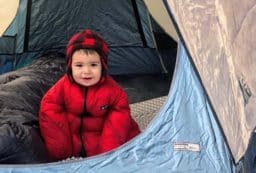
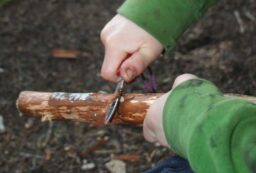
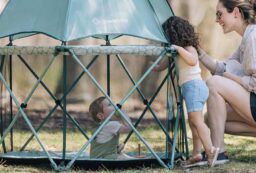







Post your comments